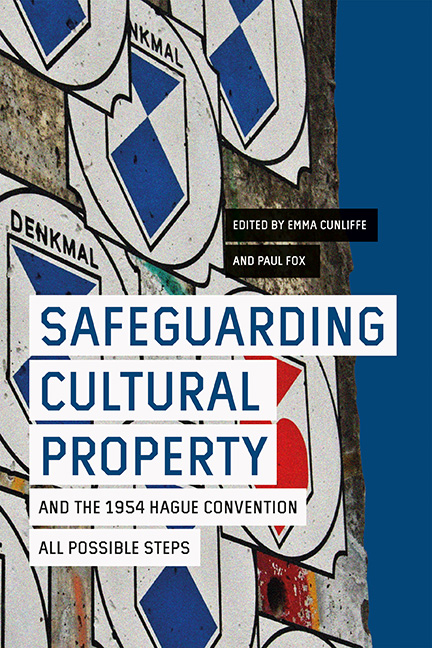Book contents
- Frontmatter
- Contents
- List of Illustrations
- List of Contributors
- Plate Section
- Acknowledgements
- List of Abbreviations
- Preface: The Blue Shield and the Protection of the World's Cultural Property – Preparing in Peace for Conflict
- Part I Safeguarding – Reassessing the Field
- Part II Historical Perspectives
- Part III Current Issues in Legal Implementation
- Part IV The Hague Convention in Practice Today: Tools and Approaches
- Appendix 1 The Hague Convention for the Protection of Cultural Property in the Event of Armed Conflict with Regulations for the Execution of the Convention 1954
- Appendix 2 Regulations for the Execution of the Convention for the Protection of Cultural Property in the Event of Armed Conflict
- Appendix 3 Resolutions of the 1954 Hague Conference
- Appendix 4 Second Protocol to the Hague Convention of 1954 for the Protection of Cultural Property in the Event of Armed Conflict 1999
- Appendix 5 Additional Protocols (1977) to the Geneva Conventions (1949) (Extracts)
- Index
- HERITAGE MATTERS
3 - Protective Measures Before the 1954 Hague Convention: The Case of the Imperial War Museum, 1933–1950
Published online by Cambridge University Press: 26 May 2022
- Frontmatter
- Contents
- List of Illustrations
- List of Contributors
- Plate Section
- Acknowledgements
- List of Abbreviations
- Preface: The Blue Shield and the Protection of the World's Cultural Property – Preparing in Peace for Conflict
- Part I Safeguarding – Reassessing the Field
- Part II Historical Perspectives
- Part III Current Issues in Legal Implementation
- Part IV The Hague Convention in Practice Today: Tools and Approaches
- Appendix 1 The Hague Convention for the Protection of Cultural Property in the Event of Armed Conflict with Regulations for the Execution of the Convention 1954
- Appendix 2 Regulations for the Execution of the Convention for the Protection of Cultural Property in the Event of Armed Conflict
- Appendix 3 Resolutions of the 1954 Hague Conference
- Appendix 4 Second Protocol to the Hague Convention of 1954 for the Protection of Cultural Property in the Event of Armed Conflict 1999
- Appendix 5 Additional Protocols (1977) to the Geneva Conventions (1949) (Extracts)
- Index
- HERITAGE MATTERS
Summary
The 1954 Hague Convention for the Protection of Cultural Property in the Event of Armed Conflict (‘the Convention’) and its First Protocol of 1954 developed from an international desire to end the devastation endured by monuments, historical and cultural sites, libraries, and museums during war, particularly the Second World War. This was followed by a Second Protocol in 1999, which updated the Convention's provisions following an evolution in international law and conflict. No conflict, however, has ever matched the cumulative desolation wrought between 1939–45. This outcome was not for the want of any cultural property protection (CPP) safeguarding measures at the time. Indeed, the Second World War included many effective – and not so effective – examples wherein CPP can be profitably studied by relevant civil and military planners today. Alongside examples of CPP occurring during earlier conflicts, the most effective safeguarding instances from 1939–45 were drawn on by the Convention's drafters in developing the text (O’Keefe 2006). Those Second World War examples of safeguarding remain important for policy makers when devising a nation state's policies on CPP today (Pollard 2020). One insightful, perhaps unexpected, example is the case of the Imperial War Museum, situated in London, United Kingdom (UK).
The Imperial War Museum (IWM) is the UK's national war museum. Founded in 1917 to commemorate efforts of the UK and British Empire over the First World War, by 1939 it had become an important cultural organisation (Condell 2002). The museum became the first national institution to strive to represent ordinary people and treat everyday items as significant (Wellington 2017, 242). In doing so, it sanctified war dead and framed objects there as ‘sacred relics’ (Cornish 2004, 46). Moreover, it accrued the most important modern British art collection, even more important than that held by the Tate (Malvern 2000, 188).
The following chapter critiques specific elements of the Convention and Second Protocol, focussing on those germane to the IWM's in situ protective measures and protective measures carried out at refuges during the Second World War.
- Type
- Chapter
- Information
- Safeguarding Cultural Property and the 1954 Hague ConventionAll Possible Steps, pp. 57 - 76Publisher: Boydell & BrewerPrint publication year: 2022



